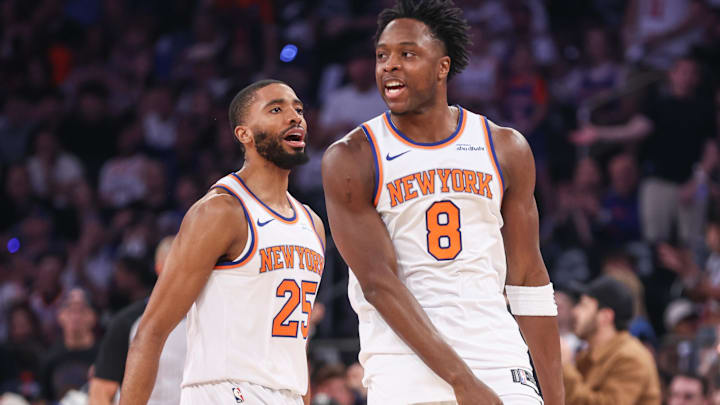There is a natural urge to set the tape from the New York Knicks’ total implosion against the Indiana Pacers on fire—to delete it from existence, and move on. That is fair, and to some extent the right call.
Still, the film isn’t all bad. The Knicks did more than a few things that can help them right the ship, and reach their first NBA Finals since 1999. There is one tactical victory, in particular, they should be looking to replicate: keeping the Pacers out of transition.
The Knicks are slowing down the Pacers
It initially looked like the Knicks would try to beat the Pacers at their own style. The start of Game 1 was frenetic, and featured absurdly quick shot-making by Indiana.
New York held its own, going punch for punch after some onset struggles. Eventually, though, the Knicks began coaxing the Pacers into burning more of the shot clock, keeping them out of transition in a way few others have done.
Fewer than 10 percent of Indiana’s offensive possessions came in fast-break situations, according to Cleaning the Glass. Across 90 combined regular-season and postseason games this year, that is just the sixth time the Pacers have spent so little time in transition. It is also noticeably lower than the team’s playoff average. Around 13.3 percent of the Pacers’ possessions were coming on the break entering Game 1.
Yes, Indiana found offensive success anyway. And we’ll get to that. But the Knicks successfully knocked them out of their usual element for large chunks of the gain. Through both the fourth quarter and overtime, for all that went wrong, the Pacers totaled just three transition points in those final 17 minutes.
You take that specific result 11 times out of 10, without knowing the final outcome. The question is: How did the Knicks do it, and more importantly, can they do it again?
For the Knicks, good offense drives better transition defense
Making shots allows you the opportunity to set your defense, and to guard against full-court sprints. New York managed to do this for much of Game 1.
Jalen Brunson and Karl-Anthony Towns scored enough—and led by Mitchell Robinson, the Knicks offensive rebounded enough—to limit the Pacers’ live-ball opportunities off rebounds and turnovers, and to force them to work deeper into the shot clock. Indiana’s average offensive possession time checked in at 16 seconds, and was around 18 seconds following a made Knicks basket, according to Inpredictable. That is noticeably higher than their playoff average of 14.1 seconds.
This should be a win for the Knicks. And it isn’t just limited to their makes. They kept the Pacers from running at warp speed after misses, too. Indiana got out in transition after a miss around 21 percent of the time, materially lower than its previous playoff average of 28 percent.
Can the Knicks do this again?
This becomes a loaded question when considering the context.
Though New York played a part in slowing Indiana down, it was also at times a conscious decision from the Pacers themselves. They invested tons of energy in targeting Brunson, and seeking him out can take time, ticking more seconds off the shot clock than is usual for them.
That is still a functional win for the Knicks. Their defense can be better in the half-court—more locked in, and better at welcoming and executing switches.
New York also has the power to slow Indiana down even further by turning over the ball less. The Pacers rallied 27 points off turnovers in Game 1, including 15 through the second half and overtime.
Credit Indiana’s defense for causing some of the havoc. But so many of the Knicks’ cough-ups were preventable, the result of brain-fart passes and lapses in overall urgency. And even if they can’t protect the ball better, they can certainly do more to track Indy’s shooters on the run. This is why you have Mikal Bridges, Josh Hart, and OG Anunoby.
This stuff can be cleaned up, and they can do more to steer the Pacers out of their wheelhouse. That alone won’t guarantee a series victory, but remember, it went a long way toward building what looked to be an insurmountable lead in the first place. So for all the Knicks wrong, for all they didn’t do good enough, Game 1 included enough meaningful silver linings that prove they still have control over their own fate.
Dan Favale is a Senior NBA Contributor for FanSided and National NBA Writer for Bleacher Report. Follow him on Bluesky (@danfavale), and subscribe to the Hardwood Knocks podcast, co-hosted by Bleacher Report's Grant Hughes.
